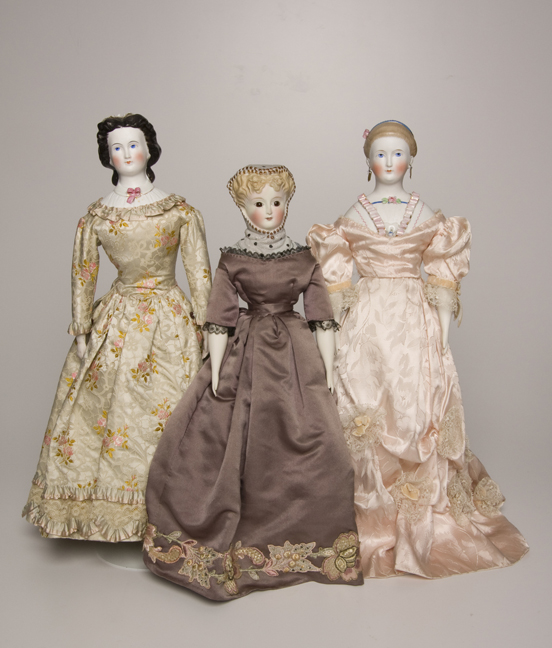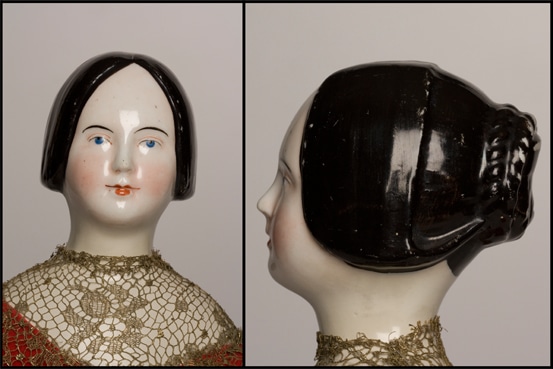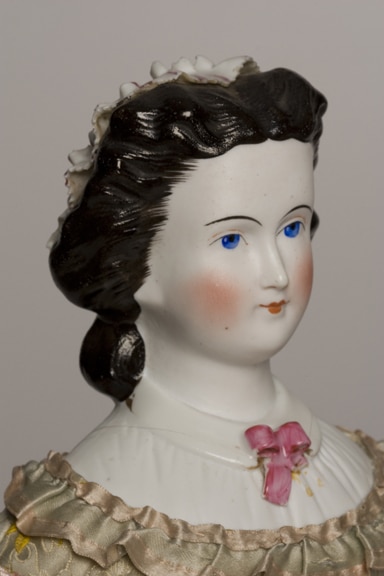I don’t know that the words curator and curious come from a common root word, but I’ve noticed that most curators—like inquisitive three-year-olds—persistently ask questions. Even curators who’ve done thorough research keep on asking questions about their subject matter. And that’s the way things should be because researchers, historians, and collectors uncover new information all the time.
 The need for questions makes me think about the museum’s collection of so-called china dolls. To be more precise, these dolls have porcelain heads (and sometimes porcelain limbs too) and came from Germany—not China. When the museum’s 700 china dolls were cataloged in the 1970s and 1980s, the curators used the latest means for identification. They knew the porcelain heads came from a thriving ceramic industry in the province of Thuringia. German makers began china-doll production around 1840 and continued until about 1930, but curators often could figure out the approximate age of a doll by its hairdo. Hairstyles changed rapidly in the 19th century, and doll makers often tried to make their dolls appear fashionably up-to-date. Early students of china dolls also noticed the quality of the porcelain itself, the delicacy of the tint in the rosy cheeks, and the similarity in the hand-painted details in the eyes, nose, and mouth. They could group dolls as having come from the same manufacturer by these details but, because most of the dolls had no manufacturers’ marks, the identity of the company itself remained a mystery.
The need for questions makes me think about the museum’s collection of so-called china dolls. To be more precise, these dolls have porcelain heads (and sometimes porcelain limbs too) and came from Germany—not China. When the museum’s 700 china dolls were cataloged in the 1970s and 1980s, the curators used the latest means for identification. They knew the porcelain heads came from a thriving ceramic industry in the province of Thuringia. German makers began china-doll production around 1840 and continued until about 1930, but curators often could figure out the approximate age of a doll by its hairdo. Hairstyles changed rapidly in the 19th century, and doll makers often tried to make their dolls appear fashionably up-to-date. Early students of china dolls also noticed the quality of the porcelain itself, the delicacy of the tint in the rosy cheeks, and the similarity in the hand-painted details in the eyes, nose, and mouth. They could group dolls as having come from the same manufacturer by these details but, because most of the dolls had no manufacturers’ marks, the identity of the company itself remained a mystery.

In the years since, curious doll collectors (first cousins to curious curators) kept digging—literally—for more information about German doll makers. One collector in particular found a novel way to gather information about manufacturers and the dolls they made. Mary Gorham Krombholz—part detective and part archeologist—traveled to the sites of old German factories and searched abandoned buildings and grounds for evidence of the companies’ products. In many instances, she found stashes of shards in dumping grounds outside factory buildings. She also uncovered bits of broken and substandard products beneath floorboards within buildings where they were tossed in winter months when the ground outside was too frozen for digging holes and dumping waste. By matching details of her mystery dolls to the shards she found at the factories’ sites, Krombholz successfully identified the manufacturers of many dolls. The books she has written of her travels and her detective work have helped many curious curators and collectors name the manufacturers of their dolls.
 At the museum, we are excited by Krombholz’s research and recent findings by other inquisitive doll scholars. We have begun a project to identify the makers of the dolls and to update our records. The work is slow going for now, but as we match dolls and makers, we’ll post the results of our sleuthing to the museum’s Online Collections. Visit the site occasionally, and you can watch our progress.
At the museum, we are excited by Krombholz’s research and recent findings by other inquisitive doll scholars. We have begun a project to identify the makers of the dolls and to update our records. The work is slow going for now, but as we match dolls and makers, we’ll post the results of our sleuthing to the museum’s Online Collections. Visit the site occasionally, and you can watch our progress.
If you’d like to know more about Mary Gorham Krombholz’s research, look for these three books: German Porcelain Dolls: 1836–2002 (2002); Identifying German Chinas, 1840s–1930s (2004); and The Story of German Doll Making, 1530–2000 (2001). All have the imprint of Hobby House Press, Grantsville, MD.



